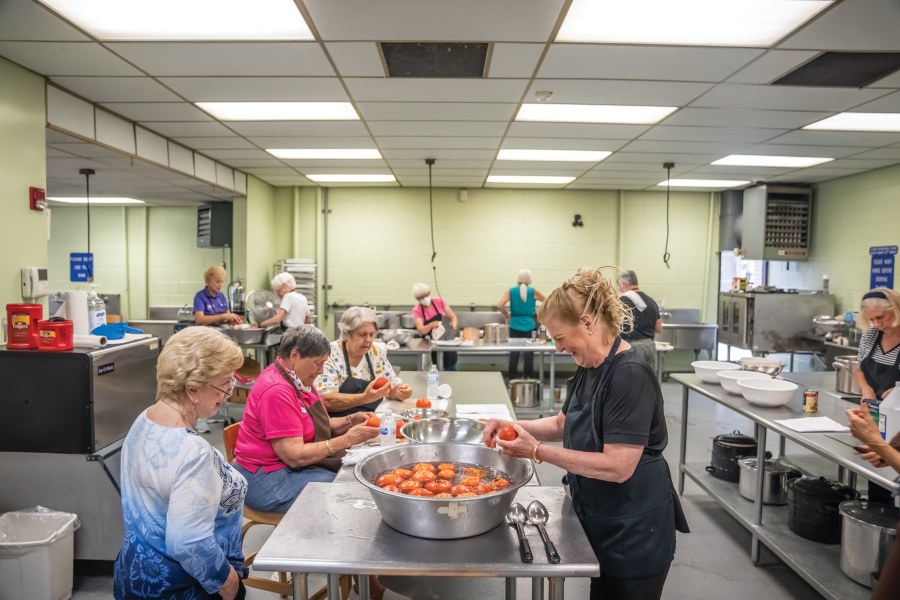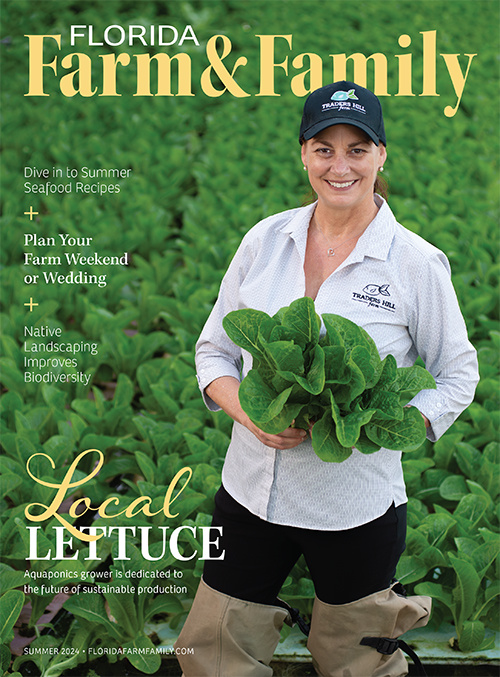
Is there anything more enticing than glass jars swirling with colorful jams, jellies, soups and sauces? They just seem to shout, “Get your homemade here,” no matter what the season.
Duval County residents have been producing homemade canned goods on a large scale for more than 75 years. What started as an open-air tin shed in Jacksonville used to can foods for county jail inmates in the 1930s slowly transitioned to a place for residents to can their victory garden surplus. In 1978, that morphed into a modern 4,000-square-foot food center, improved again in 2001 to include air conditioning.
The Duval County Extension Office oversees the facility with the help of volunteer Master Gardeners who are certified in thermal processing.
Florida has only one other public-access kitchen managed through the Extension service, located in Pasco County.
Practical and Fun

“We see the canning kitchen as an extension of our family consumer sciences program, which is all about nutrition, health and wellness, and financial stability,” says Stephanie Toelle, Duval County Extension director.
The canning kitchen is designed for residents, families, churches and other organizations, explains Phyllis Stafford, a volunteer and Master Gardener who oversees classes and other hands-on activities. She notes that people often use it to can surplus vegetables and citrus or manage dietary needs.
Once a year, Stafford hosts five couples who travel extensively by boat. They cook and can soups and meats before they leave on their trip.
“They like having a product they know is safe for consumption, and they don’t have to worry about broken glass aboard their vessel,” she says. “We’ve also had birthday parties and bridal showers, and we’ve had the scouts and home-school groups come as well.”
Teachers arrange field trips for students and may bring dry ingredients, such as a trail mix. It’s simpler, and their students can take a decorated can home with them.
There’s also the less ordinary. One woman, who often gives her four brothers jams and jellies for Christmas, decided to buy lottery tickets and can them instead. It will be a test to see if they open it – they may miss out on the winning numbers.

Taste Tests
Residents are often introduced to the kitchen through classes in a “make-and-take” format.
“Our desire is to teach people how to safely can and preserve food,” Stafford says. “We want to give them all of the techniques and skills they need to do the very same thing in their home kitchen.”
To learn more about canning opportunities and the Duval County Canning Center, visit sfyl.ifas.ufl.edu/duval/duval-county-canning-center.
Natasha Parks, family and consumer sciences agent for the Extension Service, says even though the canning kitchen can’t be used for business purposes, it can be a great training ground for a food business. The cottage food exemption states a person can earn up to $250,000 making approved products in their home for direct-to-consumer sales. These are food products you typically see at a farmers market.
“We can guide them on what they can and can’t do with the cottage food exemption,” Parks says.
See more: Florida’s Weather Allows Producers a Robust Winter Growing Season
Truly Homemade

Vegetable soup and canned chicken are the two most popular canned items.
“Our boneless, skinless chicken breast is just phenomenal. And with one can of chicken, you can do a nice salad, chicken enchiladas or combine with noodles,” Stafford says.
Canning recipes must be from an approved source, such as the U.S. Department of Agriculture, the Ball Book of Canning series or popular home magazines. It has to do with making sure it’s been tested, is stable and the pH is in a safe range.
That’s not to say a recipe passed down through the generations can’t be adapted. “You’d be surprised how often we find the same recipe in an approved source,” Stafford says.
Customers bring all ingredients and supply their own glass jars (cans are provided by the kitchen). Use of the facility is by appointment, and costs are minimal. There’s a $7.50 per hour rental fee, including processing time, plus 65 cents per quart for cans and 15 cents per jar processing fee for pints and 30 cents for quarts. All low-acid foods, such as vegetables, meats, soups and stews, go in metal cans or pressure cans. High-acid foods, such as fruits, jellies, jams and pickles, go in glass jars.
See more: Wonderful Winter Veggie Recipes
Food for Fundraisers

The Ortega United Methodist Women’s group uses the canning kitchen to make vegetable beef soup, which they sell as a fundraiser. Some of the ladies meet off-site ahead of time to prep ingredients, and the next day about 10 of them gather for 2½ hours at the canning kitchen to do the cooking.
“We make three vats, and someone with a good palate will taste,” says Gail Atchley, the group’s vice president.
Each vat makes about 65 cans. They fill cans with the beef broth/vegetable combination, add the raw meat, and it’s ready for the lids and processing, which is done by Stafford. The meat cooks in the can and “it comes out hotter than blazes,” Atchley says. The soup fundraiser has been so popular that it’s been going strong for nearly 15 years.
See more: Edible Flowers Create Mealtime Moments









Compliment of the season to your team. I’m fascinated with the great work of canning in your farm. I’m actually interested in learning how to can different food item.
I hope hearing from you.
Thank you.
This is a hidden gem! The best parts are that you have expert instruction as well as the huge pots to do large amounts all at once!
The Duval County Extension cannery is a wonderful venue for canning large amounts of food. I have used the cannery for years to can meat. I know exactly what is in the cans and have the ability to make a quick and easy meal as the meat is already cooked. It’s perfect for the days you forget to dethaw your meat.
Hi, your advertising is an answer to my prayers, I have long time to looking for someone able to reach me how to do canning for food and jams and jellies. I’m living in Cape Coral, closed to Fort Myers, please let me know what I need to do for learn some of your wonderful techniques. Thanks. Please answer me.
I would live to learn the canning process. How do I go about signing up or are ending a canning class?
I live in Dunnellon when and where is the next canning class?
When is your next canning class, I am very interested
I’m interest to take a class on canning, do you provide this?
Thank you,
Katya